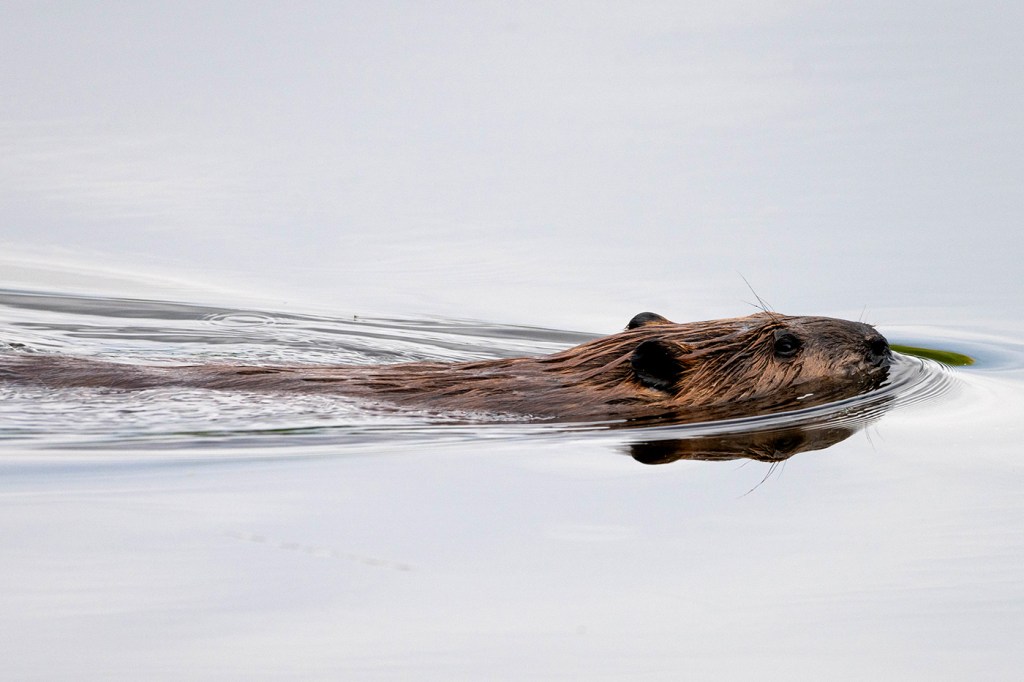Beavers are the unsung heroes of wildfire protection efforts.

From California to Washington, the West Coast is experiencing a fire season unlike any other on record. Since August, climate change-fueled wildfires have scorched more than five million acres across the three states, taking dozens of lives, destroying thousands of buildings, and making the air unbearable for millions of people.

Benjamin Dittbrenner is an associate professor in the Marine and Environmental Sciences Department and the director of the Environmental Science and Policy program at Northeastern. Photo by Matthew Modoono/Northeastern University
Benjamin Dittbrenner, an associate teaching professor in the Marine and Environmental Sciences department at Northeastern, says wetlands and beavers are an important part of the fire protection puzzle. Beaver ponds and wetlands have been shown to filter out water pollution, sequester carbon, and attenuate floods.
But perhaps a lesser-known fact about the toothy rodents is that they play a key role in creating fireproof shelters for plants and animals. And by building dams, forming ponds, and digging canals, these architects of the natural world irrigate stream corridors that help slow the spread of wildfire.
Dittbrenner, who is the director of the Environmental Science and Policy program at Northeastern, studies the effects of climate change and other types of disturbance on stream systems. Previously, in the Pacific Northwest, he used novel approaches to identify and restore degraded stream systems.
One of Dittbrenner’s techniques involved relocating beavers from areas where they were at risk for entrapment into new stream habitats. As the critters went to work building dams, Dittbrenner studied how they transformed these streams into a wetland complex—multiple wetlands that share adjacent streamside land.
“Wetlands are definitely an endangered or threatened land type,” Dittbrenner says. “There are a ton of existing wetland regulations, but human encroachment is really the biggest threat to that.”
Dittbrenner traces the degradation of streams and the disappearance of natural dams to the fur trade in the 1600s, which at the time centered on beaver pelts. Prior to the arrival of the European settlers in North America, he says, beavers existed in nearly every stream system, and dams could be found in abundance. As heavy trapping nearly extirpated the beaver population, the dams disappeared, too.
“As those beaver dams degraded and disappeared, those [wetland] systems became much simpler,” Dittbrenner says. “A lot of the wetlands that were there were gone. A lot of the sediment that was there that was doing things like pollution attenuation was gone. And the flood storage capacity was gone.”
Dittbrenner is hopeful that the recolonization of streams by beavers will aid in restoration efforts. Beaver ecosystems slow water flows. They dissipate the erosive water surge that typically occurs during big storms while capturing the sediment that comes with the water. That’s important, he says, because the erosion caused by those large storms can drop a stream channel’s bed and disconnect it from its floodplain. The resulting decrease in water availability for surrounding plants leads to forest stress, says Dittbrenner.
“[The trees] become more prone to insect infestation,” says Dittbrenner, explaining that forest pests contribute to the fires prevalent on the West Coast.
The dams also enable water to back up, producing pockets of both deep and shallow waters as well as rocky, sandy, and muddy habitats for birds, fish, mammals, amphibians, and reptiles, Dittbrenner says. As a result, he says, the number of interactions between these diverse species is higher.
“Beavers are modifying the environment to create their preferred habitat—we call them ecosystem engineers,” he says. “In doing so, they provide all of this traditional habitat for other species, and all of these additional potential ecosystem services for people as well.”
Research suggests that beaver ponds and wetland areas are vulnerable to massive fires, Dittbrenner says. The dry areas around them will often completely burn, he says, and to some extent the wetter areas are also flammable, although those tend to recover quicker.
“As we have these big fires, much of the vegetation in the forest (such as trees) is basically gone,” he says. “And it creates ash and underlying soil easily migrates when there’s precipitation. When there’s a big storm, all that ash and soil will wash—sometimes quickly—down in streams and fill up some of those streams.”
The damage is wide-ranging. Ash and sediment cover salmon egg nests, he says, suffocating the unhatched eggs because they can’t get enough oxygen. During rainfall, the absence of trees—which help slow down river and overland flow—leads to an uncontrolled surge of water and increased stream flows, putting added stress on man-made infrastructure, such as bridges and wastewater treatment plants, Dittbrenner says.
Dittbrenner has also evaluated the effect of warmer temperatures on stream flows across the Pacific Northwest as a result of snowpack depletion. One effect this has, he says, is that it causes the water to heat up faster. The warmer the water, the less amount of oxygen it can hold.
“All of that dissolved oxygen that’s no longer there creates these pretty extremely stressful situations for most aquatic species,” Dittbrenner says.
And not just aquatic species, he says. Trees lose water as well. This stress, especially when it’s systematic, makes them more prone to disease and insect infestation, creating what Dittbrenner calls a “positive feedback mechanism” that often results in environmental disasters.
“If there’s a fire, those trees might already be dried out; some might be dead,” he says. “And that standing fuel load allows for increased forest fire prevalence.”
Research shows that healthy streams promote aquatic life and nurture surrounding lands. Dittbrenner’s work provides clues to how beaver ecosystems and wetlands fit into that equation—and contribute to wildfire protection and recovery.
For media inquiries, please contact Marirose Sartoretto at m.sartoretto@northeastern.edu or 617-373-5718.





